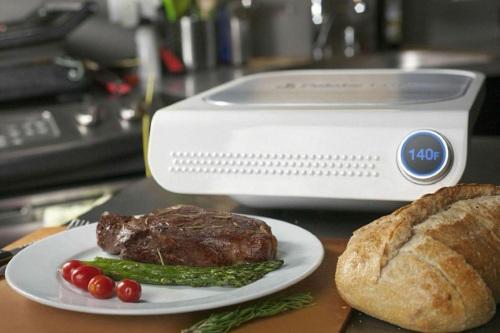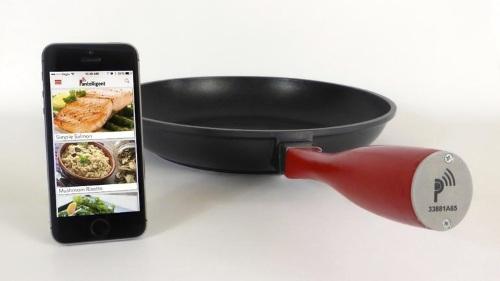An emerging Silicon Valley style of cuisine is on the rise. It should come as no surprise that it has a scientific bent and uses sensors, microcontrollers, wireless networks and mobile apps. Consider this your invite to a high-tech cook off in July.
A handful of startups are putting a new spin on the old stereotype of the Internet refrigerator that sends you a text when you need to buy milk. This time around the goals are more diverse, useful and tasty.
“I’m sick of discussions dominated by the Internet refrigerator,” said Jim Reich, a CTO of Palate Home Inc., a San Francisco startup making a connected precision grill for consumers. “Kitchen devices can have higher value than that because this is an area where you can make a big difference in people’s lives,” he said.
For its part, Palate Home is about to ship alpha units of its Palate Smart Grill, a device that aims to bring consumers the sous-vide experience offered in top restaurants. I had to look up sous vide to find out it’s a method of slow cooking food often in sealed bags in relatively low temperature water baths, popularized in the 1960’s.
According to the Palate Home Web site:
The best chefs have specialized tools for precision cooking, like combi ovens which cost tens of thousands of dollars and require a dedicated water line. We’ve optimized this precision-cooking technique for the home chef in an electric grill. [It requires] just one minute for setup, and one minute when you’re ready to eat. Powerful software and advanced sensors automatically adjust the cooking profile to give optimum results for your exact food.
Reich planted the idea in my head to organize a session on “Cooking with IoT” at the Embedded Systems Conference in Santa Clara where I am also helping organize a broader session on the Internet of Things.

The Palate Home Smart Grill promises sous-vide cooking with consumer ease.
Intelligent pans, connected scales

Pantelligent puts sensors in a frying pan controlled by a smartphone app.
There are plenty of potential panelists for our “Cooking with IoT” session.
For instance, at least three companies are already selling networked sous-vide devices. Sansaire is selling a $199 gadget, Nomiku has $299 and $129 versions — it claims the latter is the first to use WiFi (shipping in April) — and Anova Culinary has a $179 Bluetooth model and a $599 pro version that cooks up to eight pounds of food in 15 gallons of water.
If you want something simpler, you can try Pantelligent, an intelligent frying pan. It uses temperature sensors and an iPhone app filled with menus to monitor cooking of everything from your breakfast bacon to dinner scallops.
Pantelligent raised more than $83,000 from 464 backers in a Kickstarter campaign listed as a staff pick by the crowdfunding site. Chief executive Humberto Evans said the startup is working on fulfilling those orders and then ramping up for a broader market. Getting this far wasn’t easy, he said.
We are basically putting electronics somewhere they have not been before so a lot of weird things have come up. Early prototype pans literally exploded because we were dealing with glues and curing times of cement, so some pan bottoms flew off until we found out how to mount the sensors.
Pantelligent and Palate Home will both cook up a little something to sample at our Silicon Valley event in July along with another panelist or two TBD. As a lover of baked goods, I’m keeping my fingers crossed we can get a representative from Drop.
The Drop Kitchen Connected Scale has a wide range of uses with baking one of its strengths. The Bluetooth device is geared for use with iOS3 iPads with iPhone and Android apps in the works.
We’ve also reached out to The Orange Chef, maker of a connected scale that links to iPads and the Jawbone Up wristband. Both the Prep Pad and the Drop Scale aim to help promote and track healthy eating as well as making cooking easier.
“There will be quite a few products coming out in the next year or two that will change how we work in the kitchen,” said Evans of Pantelligent. “We all pretty much know each other, but we’ve never been in the same room,” he added.
Source: Rick Merrit, eetimes, 2/3/2015, link: http://tinyurl.com/q94y2e9
Posted by Hairol on 2/7/2015
No comments:
Post a Comment